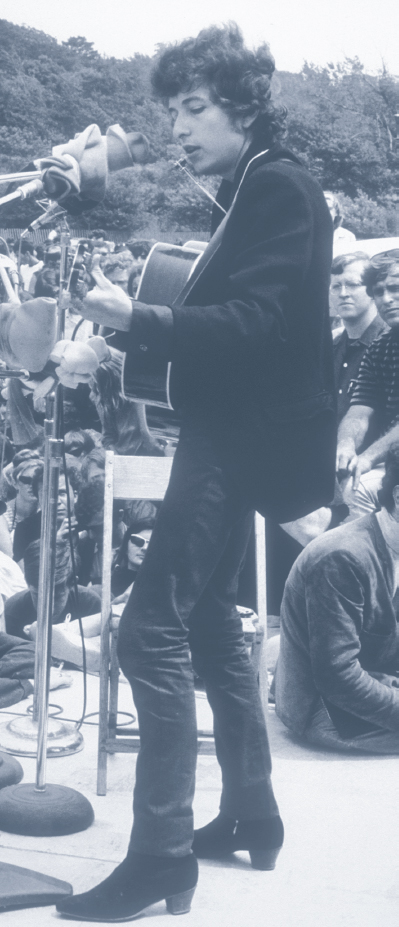Folk and Psychedelic Music Reflect the Times
Popular music has always been a product of its time, so the social upheavals of the Civil Rights movement, the women’s movement, the environmental movement, and the Vietnam War naturally brought social concerns into the music of the 1960s and early 1970s. Even Motown acts sounded edgy, with hits like Edwin Starr’s “War” (1970) and Marvin Gaye’s “What’s Goin’ On” (1971). By the late 1960s, the Beatles had transformed themselves from a relatively lightweight pop band to one that spoke for the social and political concerns of their generation, and many other groups followed the same trajectory. (To explore how the times and personal taste influence music choices, see “Media Literacy and the Critical Process: Music Preferences across Generations”.)
Folk Inspires Protest

The musical genre that most clearly responded to the political happenings of the time was folk music, which had long been the sound of social activism. In its broadest sense, folk music in any culture refers to songs performed by untrained musicians and passed down mainly through oral traditions, from the banjo and fiddle tunes of Appalachia to the accordion-led zydeco of Louisiana and the folk-blues of the legendary Lead Belly (Huddie Ledbetter). During the 1930s, folk was defined by the music of Woody Guthrie (“This Land Is Your Land”), who not only brought folk to the city but also was extremely active in social reforms. Groups such as the Weavers, featuring labor activist and songwriter Pete Seeger, carried on Guthrie’s legacy and inspired a new generation of singer-songwriters, including Joan Baez; Arlo Guthrie; Peter, Paul, and Mary; Phil Ochs; and—perhaps the most influential—Bob Dylan. Dylan’s career as a folk artist began with acoustic performances in New York’s Greenwich Village in 1961, and his notoriety was spurred by his measured nonchalance and unique nasal voice. Significantly influenced by the blues, Dylan identified folk as “finger pointin’” music that addressed current social circumstances. At a key moment in popular music’s history, Dylan walked onstage at the 1965 Newport Folk Festival fronting a full, electric rock band. He was booed and cursed by traditional “folkies,” who saw amplified music as a sellout to the commercial recording industry. However, Dylan’s move to rock was aimed at reaching a broader and younger constituency, and in doing so he inspired the formation of folk-rock artists like the Byrds, who had a No. 1 hit with a cover of Dylan’s “Mr. Tambourine Man,” and led millions to protest during the turbulent 1960s.
Rock Turns Psychedelic
Alcohol and drugs have long been associated with the private lives of blues, jazz, country, and rock musicians. These links, however, became much more public in the late 1960s and early 1970s, when authorities busted members of the Rolling Stones and the Beatles. With the increasing role of drugs in youth culture and the availability of LSD (not illegal until the mid-1960s), more and more rock musicians experimented with and sang about drugs in what were frequently labeled rock’s psychedelic years. Many groups and performers of the psychedelic era (named for the mind-altering effects of LSD and other drugs) like the Jefferson Airplane, Big Brother and the Holding Company (featuring Janis Joplin), the Jimi Hendrix Experience, the Doors, and the Grateful Dead (as well as established artists like the Beatles and the Stones) believed that artistic expression could be enhanced by mind-altering drugs. The 1960s drug explorations coincided with the free-speech movement, in which many artists and followers saw experimenting with drugs as a form of personal expression and a response to the failure of traditional institutions to deal with social and political problems such as racism and America’s involvement in the Vietnam War. But after a surge of optimism that culminated in the historic Woodstock concert in August 1969, the psychedelic movement was quickly overshadowed. In 1969, a similar concert at the Altamont racetrack in California started in chaos and ended in tragedy when one of the Hell’s Angels hired as a bodyguard for the show murdered a concertgoer. Around the same time, the shocking multiple murders committed by the Charles Manson “family” cast a negative light on hippies, drug use, and psychedelic culture. Then, in quick succession, a number of the psychedelic movement’s greatest stars died from drug overdoses, including Janis Joplin, Jimi Hendrix, and Jim Morrison of the Doors.